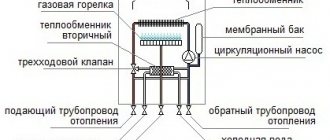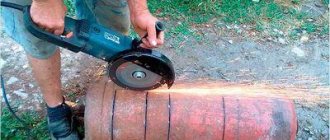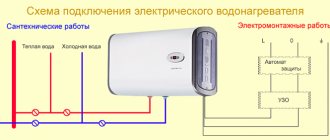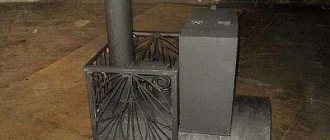Any waste, which for an ordinary person is just garbage that needs to be disposed of, in the hands of a master can bring tangible material benefits.
For example, scraps of pipes of different sizes, an old gas cylinder and other metal scraps will be turned into a furnace, and waste oil will be turned into fuel. Organizing heating using waste oil with your own hands is not so difficult.
We will tell you about the main options for installing heating systems using waste fuel. The article we have proposed describes in detail how to manufacture home-made devices that have been tested in practice. Taking into account our recommendations, you can achieve optimal results.
Operating principle of waste oil boilers
Appearance of used oil
It is possible to set up full-fledged air heating using waste oil only after familiarizing yourself with the specific design of boilers. This type of fuel is similar in technical characteristics to diesel, but has a larger number of additives. They arise due to the specific use of oil - in a car, industrial vehicle, etc.
Therefore, many factory heating boilers using waste oil are in fact diesel. Their principle of generating thermal energy is similar to a car engine. With the help of a pump, fuel is supplied to the nozzle while simultaneously pumping a large amount of air. This mixture ignites, producing large amounts of thermal energy.
An alternative option is to make your own waste oil heating boiler. In it, fuel burns as in conventional solid fuel. However, the efficiency of the system is much lower. Therefore, experts recommend installing factory models.
The principle of operation of a waste oil boiler
This is due to their advantages:
- Accurate calculation of fuel consumption and air supply to the injector;
- Reliability and safety of operation;
- Organization of a carbon monoxide removal system;
- Preheats fuel to improve combustion efficiency.
But at the same time, heating a house with waste oil using factory boilers is characterized by high initial costs. You can reduce them slightly by purchasing a burner that is installed in a solid fuel boiler.
The nozzle diameter for waste oil must be larger than for diesel fuel.
Main types and classification
According to their purpose, heating devices are divided into groups:
- stoves for domestic needs;
- boilers for heating water;
- heating units.
According to their intended purpose, the devices are for domestic needs.
Based on the method of heating the room, they are classified as:
- air heaters, which directly increase the room temperature through contact with the warm walls of the housing;
- boilers with coolants that transport heat through pipelines from the source to the radiators.
All boiler designs are divided by function into single- and double-circuit. The former are intended only for heating areas, the latter, in addition to heating the coolant or air in the room, heat water for domestic needs. An exhaust boiler with a water circuit allows you to reduce energy costs.
There are several end consumers. In such cases, more than one water circuit is planned.
Feasibility of installation
Heating scheme using waste oil
Is it really profitable to heat a country house using waste oil? This heat supply option can only be used if relatively cheap fuel is available. Otherwise, it will not be economically feasible to install complex and expensive equipment.
Heating a country house using waste oil, in addition to the boiler, must include a container for storing fuel. It has special requirements. The use of open barrels is strictly prohibited, as used oil gradually evaporates. This requires closed containers. In addition to them, pumping equipment will be required to supply fuel to the combustion chamber.
Summarizing all the above factors, we can identify the main requirements for the feasibility of heating with waste oil for a private home:
- Access to cheap fuel . For a house of 150 m² with 9 hours of heating, about 22.5 kg of oil will be required per day. During the heating season, this figure will be about 2200 kg;
- Special storage container . Its capacity must be at least 2 months' consumption, i.e. about 500 kg;
- It must be remembered that the amount of soot in a heating furnace using waste oil will be an order of magnitude greater than that of diesel or solid fuel. In this regard, the frequency of cleaning the combustion chamber and chimney will increase.
Also, do-it-yourself heating using waste oil involves installing a fan rather than a turbine. This reduces the air flow, which affects the composition of the combustible mixture. This technology leads to rapid clogging of the nozzle and frequent failure.
You can negotiate with the nearest car service center to purchase used oil. It is best to do this 4-5 months before the start of the heating season.
Results
Thus, do-it-yourself oil heating is a fairly economical system, and at the same time, worthy of replacing other heating systems. Such systems are also used for autonomous heating. However, the specificity of this option lies precisely in the fuel used, so this alternative is considered as an extreme case: when there are no other options or there is a lot of used oil. The main area of application for such devices is industrial enterprises, where among the waste there is a large amount of used oil.
Security measures
Homemade installation using waste oil
The most important question for the consumer remains: is steam heating using waste oil safe? All complaints about an unpleasant odor and fuel combustion are related to non-compliance with safety rules.
It is important to choose the correct composition of used oil. It should not contain waste gasoline, acetone and other flammable substances. You should also pay attention to third-party impurities typical of automotive waste. They are the cause of premature contamination of the burner.
For air heating using waste oil, the following safety measures must be provided:
- Chimney with a diameter of at least 100 mm. It is best to use a sandwich chimney, since the least soot forms on its surface;
- It is not allowed to store fuel containers in the immediate vicinity of the boiler;
- Tanks with used oil must be sealed. If water gets into them, fuel will splash during combustion. This may cause a fire;
- The temperature impact on a heating boiler using waste oil is much higher than that of solid fuel. Therefore, the wall thickness of the heat exchanger and combustion chamber cannot be less than 2 mm;
- To avoid smoke in the boiler room, a forced circulation system is installed in it. The recommended air exchange should be 180 m³/hour per 1 m³ of area.
Only after meeting these requirements can we talk about a safe heating system for a country house using waste oil.
The operation of a fan or turbine can draw a large volume of air from the boiler room. Therefore, the power of the room’s ventilation system should be 1.2 times higher.
How to weld a simple stove
Then the heat is released in greater quantities into the room, rather than being “thrown out” to the street.
Another upgrade is to make an iron drawer. Oil is poured into it. With this design, the stove is easier to maintain. The drawing contains all the necessary dimensions. Before assembling a homemade oil stove, it is necessary to select the correct diameter of the firebox and body. Here everything depends on the volume of the room that needs to be heated. If it is a garage of 3 by 6 meters, take a profile of 80x80x4 mm. The fuel box is made of metal 60x60x4. It is more difficult to work with round rolled metal.
The step-by-step instructions look like this:
- Cut the metal according to the drawings to make a casing, drawer, afterburner. If the latter has a bend, the tube is cut at an angle of 45 degrees.
- For a profile of a smaller standard size, one wall is cut out with a grinder. Plugs are welded to the sides. The result is an open container to which you need to attach a handle.
- The structure is welded. It is necessary to drill an air hole at the top of the fuel chamber. The pipe is perforated. At this point the work is completed.
It should be taken into account that you need to calculate the number and diameter of holes in the afterburner. If you use a profile of 80 by 80 mm, then the cross-sectional area will be equal to 6400 square millimeters. This value is divided in two
Pay attention to the markings of the drill used. If it is 8 mm, then the hole area will be 50 sq. mm
Now 3200 must be divided by 50. The result is that 64 holes will be required to work effectively. However, as a result of customization, their number can be increased.
It is important that the chimney is of sufficient length. The elevation of the chimney outlet must be at least 5 meters
Then the operation of the stove during testing will ensure the highest possible efficiency even without supercharging. Otherwise, the pipe will have to be extended to this mark. But you can further increase productivity if you organize an inclined chimney running along the wall. The heated metal will release heat into the room. Only in this case is it important to follow fire safety rules. There should be no wooden shelves above the pipe, and no wallpaper on the walls. Even better is to cover the wall with a metal sheet.
Making a drip heater
Professionals who have assembled more than one “dripper” use old propane cylinders with a diameter of 200 mm. Oxygen ones are also suitable, since their cross section is 220 mm. the latter benefit due to thick walls. They serve for a long time, do not burn out, and accumulate heat. Pipe C-10 is also suitable if it has a wall thickness of 5 mm. An excellent option for a durable housing is pipes made of heat-resistant stainless steel alloys, alloyed chromium, molybdenum or nickel (for example, 15X1MF or 12X18H12T) with a wall no more than 3 mm. However, it is not advisable to specifically purchase this raw material due to its high cost.
Technologically, the manufacturing process is as follows:
- A flame bowl is made using a piece of pipe or ready-made steel containers. This one is pulled out through a rubber hatch, so it is not made too big.
- The openings necessary for connecting the chimney pipe and the cleaning service hatch are cut out in the body. The latter is framed and closed with a door. Bolts can be used for fastening.
- An afterburner is being made. All holes are not made at once. Usually the bottom 2-3 rows are drilled, and the rest are drilled during the setup process. If you do everything at once and there are too many of them, you will have to make a new one.
- Weld the cover with the air duct and flange. The latter is necessary for installing the fan. The fuel supply device is connected. Photo and video instructions will help here.
Now assemble all the components and connect the electrical wiring. The structure will be more stable if you make a metal frame. A heavy metal profile is suitable for this.
Overview of heating boiler manufacturers undergoing testing
Factory waste oil burner
Reliable heating using waste oil, reviews of which are mostly positive, is impossible without a factory burner. The safety and efficiency of the heating system at home will depend on it. Currently, the market is dominated by foreign manufacturers of this type of equipment. This is due to the labor intensity of production and the relatively low demand among Russian consumers for heating boilers during testing. Most models are designed for heating large rooms, and their power exceeds 60 kW. But despite this, it is possible to organize heating using waste oil in a private home using less efficient burners.
Clean Burn boilers
The American company specializes in the production of powerful waste oil boilers. Its products are in demand in boiler houses for heating 2-3 apartment buildings. The minimum boiler power is 200 kW. A special feature is the unique shape of the heat exchanger, providing 95% efficiency.
Kroll burners
The German manufacturer specializes in the production of burners operating on waste oil. It is important that the company’s engineers took into account the specifics of heating a house using waste oil - the burner can be installed on almost any type of solid fuel boiler. In addition, it has a unique fuel heating system so that its viscosity is close to ideal.
A special feature is the mandatory presence of compressed air, which can be generated using a compressor. This is a prerequisite for organizing heating using waste oil with your own hands.
Boilers Heat
This Russian manufacturer is one of the few who were able to make truly unique heating equipment using waste oil. Their heating boiler "Zhar-20" with a nominal power of 30 kW can be installed in a private home. It does not take up much space, and all safety measures for waste oil steam heating are taken into account.
The price of equipment from the above-described manufacturers depends on the power of the boiler (burner) and its design features.
| Model | price, rub. |
| Kroll KG/UB, 75 kW/hour | 270000 |
| Clean Burn SV-2000, 200 kW | 580000 |
| Zhar-20 | 170000 |
Before purchasing a specific boiler model, it is recommended to read reviews on heating using waste oil. They will help you form an objective point of view on the performance of specific equipment.
Scope of use
The first such units were developed in order to dispose of waste oil products (they were called that way: recyclers). They were designed so that the percentage of harmful emissions was minimal. A little later they figured out how to use the generated heat for heating, after which many modifications of the devices appeared.
Visual operating principle of the burner Source gwsigeps.com
Modern heat generators are varied in design; They are designed for heating the following premises:
- Car service centers, technical centers, hangars.
- Locksmith workshops, industrial premises, warehouses.
- Other industrial premises, private houses and summer cottages.
Any natural or synthetic waste oil, or a mixture of several oils, is suitable for use. The fuel can be oil:
- waste: motor, hydraulic, transmission, transformer (from machine tools and any equipment);
- drained from cars, hydraulic equipment, diesel locomotives;
- drained from a cooking unit (for example, a deep fryer);
- vegetable oils: rapeseed, soybean, corn, sunflower (waste);
- diesel fuel, kerosene.
- fuel oil, heating oil.
Homemade waste oil boiler
Homemade waste oil stove
A heating stove using waste oil is not always necessary to supply heat to a home. In some cases, it is made for heating the garage and utility rooms. Then it is almost impossible to select a factory model of a burner with a power of up to 10 kW. The only way out is to do it yourself.
The operating principle of this device is based on burning a mixture of oxygen and oil. During the combustion of this composition, the water tank located in the upper part of the structure is heated. To make such a heating boiler using waste oil with your own hands, you will need to select the right starting materials. The temperature in the combustion zone can reach +700°C, so it is best to use heat-resistant steel grades.
Scheme for making a homemade boiler
To supply air you will need a small power compressor. The hose from it is installed in a pipe located next to the waste oil reservoir. For ignition, a piezoelectric element or a similar device is installed.
Unlike factory burners, steam heating using waste oil has its own specific operation. It lies in the principle of obtaining thermal energy. Let's look at the stages of heating using waste oil using a homemade boiler:
- The oil heats up to +40°C, resulting in the formation of vapors that enter the upper chamber;
- In the combustion zone, air is mixed with the fuel mixture, resulting in the release of a large amount of heat;
- The resulting energy can be directed to heating water in the upper heat exchanger or supplied directly to the room through the walls of the combustion chamber.
For this homemade waste oil boiler, it is important to make the chimney system correctly. It must freely remove combustion products outside the room. The high oxygen consumption during fuel combustion should also be taken into account. Therefore, to heat a country cottage using waste oil, an autonomous air supply system is made.
To regulate the boiler power, a tap is installed on the air supply hose. With its help, you can reduce (increase) the flow of oxygen and the composition of the combustible mixture.
Design options
To burn fuel in homemade boilers, 3 methods are used:
- open combustion of petroleum products in a tank followed by afterburning in a secondary chamber (pyrolysis transformation of a flammable agent);
- self-made or industrial burners (Babington design);
- drip method with forced air injection.
Depending on the choice of unit option for flame formation, a further design option is developed.
The drip method is used to burn fuel.
An indoor air heater without a water jacket consists only of a container for burning waste and illustrates the very principle of operation. A container with a portion of fuel is on the floor, the flame evaporates the oil, which burns in the afterburner, and the hot gas rushes upward, heating up the air heater.
The design with drip feed of mining is recommended for beginners for the following reasons:
- oil burners with a complex design require additional pressure compressors and are capricious in operation;
- the process of surface combustion is fire hazardous, making a water heat sink for such a unit is not easy;
- the dropper is easy to make, it works without automation, and does not require labor-intensive preventive work.
It differs from other designs in the following respects:
- fuel is dosed in drops that fall to the bottom of the container, where they evaporate and burn in an afterburner;
- the heat exchanger is a metal casing, inside of which a secondary chamber is placed;
- forced air flow is carried out through it.
The complexity of the design is compensated by efficiency, safety and ease of use.
From a cylinder
Oxygen (d=220 mm) and propane (d=300 mm) cylinders that are unsuitable for use are used as a cost-effective replacement for the high-tech steel of the boiler body.
You can make a budget boiler from a cylinder.
Manufacturing Features:
- the dropper is made of stainless steel with a thickness of no more than 3 mm according to drawing 2.
- take a ready-made bowl for the flame or make it taking into account subsequent extractions through the inspection hatch;
- cut out holes for the chimney and lower hatch, attach the door to it;
- 3-4 rows of holes are initially drilled on the afterburner, the remaining holes are added to the design during debugging;
- install an air duct with a mount for a fan, which is equipped with a speed controller for dosing the air flow;
- connect a fuel line with a supply regulator (automatic waterer for livestock);
- a frame is welded to the body to provide vertical stability;
- after trial runs, the productive operating mode of the unit is adjusted (at the same time, they are guided by the color of the flame: blue - complete combustion, yellow - normal, red - a signal for adjustment by drilling additional holes in the secondary chamber).
The main sign of a correctly adjusted boiler is colorless smoke from the chimney, without soot from unburned hydrocarbons and soot.
When changing oil with a different composition, the combustion characteristics and drip rate change.
Reviews about heating using waste oil
How can you determine the relevance of installing a waste oil heating furnace? There are many criteria - calculated efficiency indicator, operating comfort. However, the most effective way to find out about possible problems is to read reviews about heating using waste oil:
- We decided to install air heating in our car service during testing. Fortunately, there is always plenty of fuel. We installed a homemade boiler and conducted “field tests”. The first problem is the mandatory cleaning of the oil before filling. Even a small amount of antifreeze (which happens often) significantly increases the volume of soot. After updating the system, everything functions normally;
- We have heard a lot about heating a private house using waste oil - efficiently and at low cost. My husband works in electrical networks and managed to negotiate the sale of transformer oil at a good price. We installed a German burner on an old boiler and made a proper fuel supply. The system works like a clock. The only drawback is the high consumption - in winter up to 25 kg per day;
- I made a homemade boiler for the garage during testing. It works fine - I installed a good chimney in advance. The walls of the boiler become red hot and therefore you have to blow them with a fan. He also noted that the firebox needs to be cleaned frequently.
From operating experience, it will take from 1 to 3 years to compensate for the initial costs of installing equipment using waste oil. This only applies to boilers with a power of 60 kW and above.
The video shows an example of how a homemade boiler works:
Features of burner manufacturing
Made with your own hands, it should have a small size, and in appearance it will resemble a gas cylinder. Pipe sections made of metal are fixed to the body at the top and bottom. They must be strengthened by welding, and positioned opposite to each other. The lower section is needed in order to supply the oil-oxygen suspension to the compartment where combustion takes place. The upper section is used as a burner flare. A torch of flame with a significant temperature erupts from it. In order to ensure air flow into the structure for the formation of a flame, a household vacuum cleaner is used; it is necessary to use one that has significant power.
Case manufacturing
So, first of all, the details of the future unit are prepared. The body of the heating device will be made from a 425 mm pipe. For a small heating boiler, a height of 1.0-1.2 m, taking into account the small diameter, is the best option.
We cut the pipe to these dimensions using a gas cutter. We process the edges with a grinder.
Openings for firebox and ash pan
Now you need to cut two holes in the body: for the firebox and for the blower. They should be rectangular. A size of 20x10 cm is suitable for the firebox, 20x3 cm for the blower. They are located one above the other, the firebox hole is higher.
The distance from the edge of the pipe to the blower is within 5-7 cm. The distance between the holes is 5 cm. The edges of the hole are processed with a grinder. A cut piece of the firebox pipe wall will be used as a door. Its edges are also cleaned.
Holes for pipes
Using a cutter, two more holes are cut for the supply and return pipes with a diameter of 25 mm. The holes are located opposite each other. In this case, the return hole is cut out on the side of the boiler above the firebox: from the firebox hole at a distance of 15 cm.
At a distance of 5 cm only from the upper edge of the housing, a hole is cut to supply coolant. Two bends can be welded to these holes right there.











